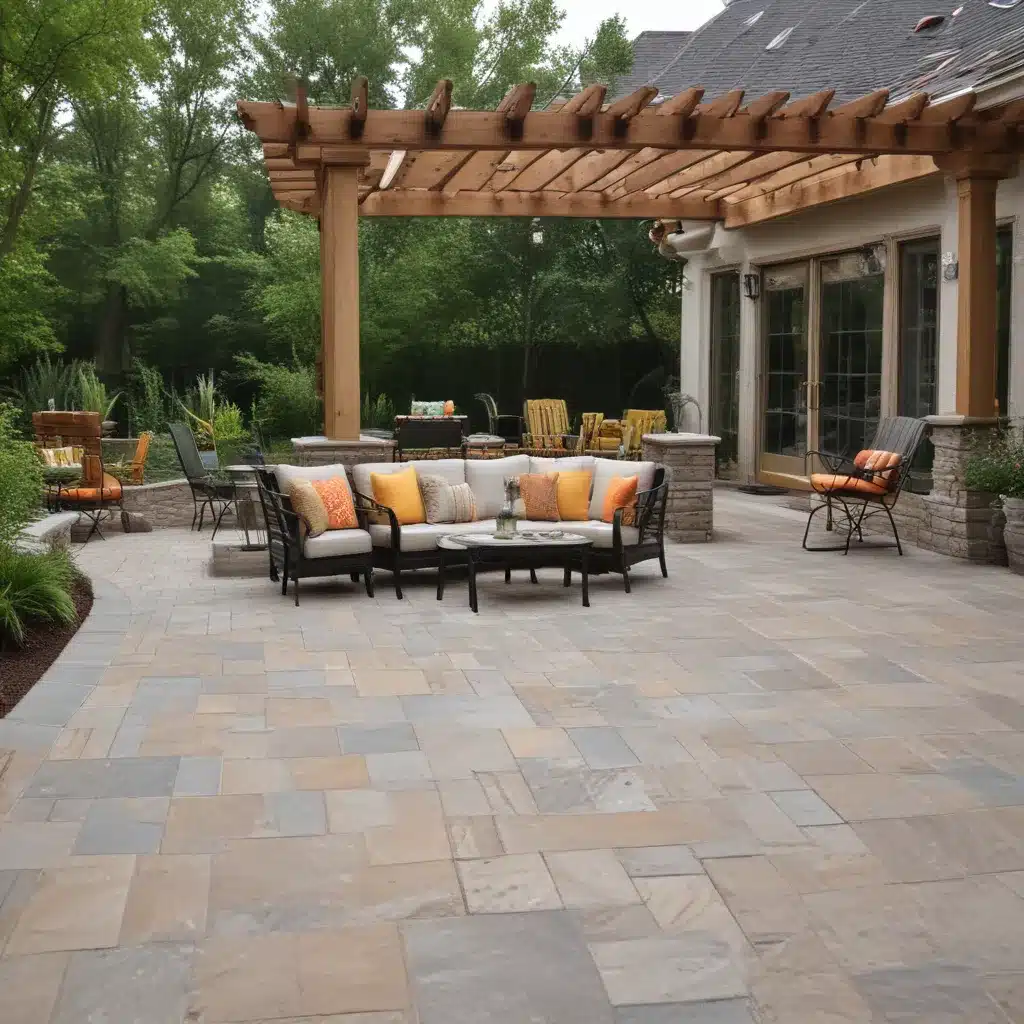
The patio is the centerpiece of any outdoor living space – a blank canvas waiting to be transformed into a functional, aesthetically-pleasing extension of your home. From elegant stone pavers to low-maintenance composite materials, the options for patio paving have never been more diverse. Whether you’re looking to create a sophisticated entertaining area or a cozy, intimate setting, strategic patio design can elevate your property’s curb appeal and maximize your enjoyment of the great outdoors.
Patio Paving Trends
When it comes to patio paving, the latest design trends prioritize sustainability, textural diversity, and integrated lighting to craft truly captivating outdoor environments. Let’s dive into each of these key elements:
Sustainable Paving Materials
Today’s eco-conscious homeowners are increasingly seeking out paving solutions that minimize environmental impact without compromising on style or durability. Permeable pavers, which allow water to permeate through to the soil below, have become a popular choice, as they help reduce stormwater runoff and promote groundwater recharge. Recycled materials like reclaimed brick or crushed glass aggregates also offer a greener alternative to traditional paving.
Textural Diversity
In contrast to the flat, monotonous look of basic concrete, today’s patios feature a rich tapestry of textures and patterns. Natural stone like flagstone, travertine, or bluestone lends a timeless, elegant aesthetic, while interlocking concrete pavers in a variety of shapes, sizes, and colors can create dynamic, eye-catching designs. Mixing and matching different paving materials within the same space is a clever way to add visual interest and define distinct zones.
Integrated Lighting
Thoughtful lighting is essential for transforming a patio into a truly inviting, functional outdoor living space. In-ground lighting can elegantly illuminate pathways and steps, while strategically placed uplighting and downlighting can highlight architectural features, landscaping, or gathering areas. Some homeowners are even opting for solar-powered lighting solutions to reduce energy costs and environmental impact.
Outdoor Design Ideas
Beyond the selection of paving materials, successful patio design involves thoughtful zoning, the incorporation of focal points and accents, and a seamless integration with the home’s interior.
Zoning and Functionality
Dividing the patio into distinct functional zones – such as a dining area, lounge space, and cooking station – can help maximize the use of the available square footage. This strategic layout not only enhances the flow of the space but also allows you to tailor the paving materials, furnishings, and accessories to the specific needs of each zone.
Focal Points and Accents
Incorporating eye-catching focal points, like a statement water feature or an outdoor fireplace, can instantly elevate the visual appeal of a patio. Complementary accents, such as decorative planters, sculptural art, or ornamental lighting, help tie the entire space together and create a cohesive design.
Seamless Indoor-Outdoor Flow
For a truly immersive outdoor living experience, focus on creating a smooth transition between the interior of your home and the patio. Aligning the patio’s paving materials with the flooring inside, using consistent design elements, and ensuring a level threshold can help blur the lines between indoors and out, allowing the two spaces to flow harmoniously.
Installation Techniques
Proper patio installation is essential for ensuring a durable, long-lasting outdoor living space. Here are some key considerations for each stage of the process:
Preparing the Base
A stable, well-compacted base is the foundation for any successful patio. This typically involves excavating the area, adding a layer of gravel or crushed stone, and compacting the base to create a smooth, level surface.
Laying the Pavers
The paving material itself is then carefully installed, with attention paid to proper spacing, alignment, and edge treatment. For interlocking pavers, this may involve the use of a mechanical plate compactor to secure the units in place. Natural stone patios often require a mortar base for a more permanent, solid installation.
Finishing Touches
The final stage of patio installation involves adding edge restraints, applying joint sand or grout, and ensuring proper drainage. These finishing touches not only enhance the overall aesthetic but also contribute to the long-term durability of the patio.
Maintenance Guidelines
Caring for your patio is an important step in preserving its beauty and functionality over time. Here are some essential maintenance tips to keep in mind:
Cleaning and Sealing
Routine cleaning with a mild detergent and water, along with the periodic application of a protective sealer, can help keep paving materials looking their best. This is especially important for porous materials like natural stone or concrete pavers, which are susceptible to staining and weathering.
Repair and Replacement
Inevitable wear and tear may require the occasional repair or replacement of damaged pavers. Carefully matching the existing materials and following the proper installation techniques can help maintain a cohesive, seamless appearance.
Winterization Strategies
In colder climates, taking steps to protect your patio from the elements, such as clearing snow and ice or applying a de-icing agent, can help prevent cracking, spalling, or other cold-weather damage.
Cost Considerations
When budgeting for a patio project, it’s important to account for not only the initial material and installation costs but also the ongoing maintenance expenses.
Material Expenses
The cost of paving materials can vary widely, from budget-friendly concrete pavers to high-end natural stone. Factors like size, color, and texture can all impact the overall material expenses.
Labor and Installation Costs
The complexity of the patio design, the scope of the project, and the expertise of the installation team can all influence the labor costs. Professional installation is generally recommended to ensure a durable, long-lasting patio.
Long-Term Maintenance Budgeting
Allocating funds for regular cleaning, sealing, and potential repairs should be factored into the overall patio investment. Consulting with a reputable outdoor living specialist can help you determine a realistic maintenance budget for your specific patio needs.
By carefully considering the latest patio paving trends, design strategies, installation techniques, and maintenance requirements, you can transform your outdoor living space into a true backyard oasis. For more information and personalized guidance, be sure to contact the experts at Cincinnati Patiopaving to start planning your dream patio project.

